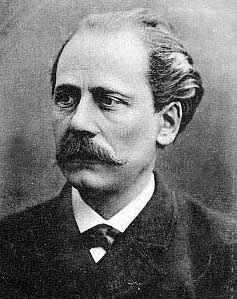Jules Massenet
b St. Etienne, May 12, 1842; d Paris, August 13, 1912
Jules Massenet was the most prominent and prolific composer of French opera in the late 19th and early 20th centuries with more than 30 operas to his credit. Born the twelfth child in a typical bourgeois provincial family, Jules first studied piano with his mother. His skills were sufficient to be accepted by the Paris Conservatoire, where in 1859, he won first prize for piano performance. He spent his early adulthood giving lessons, providing entertainment at local cafés and playing timpani in the orchestra pits of the major opera houses.
Massenet studied composition with Ambroise Thomas, a celebrated composer of an earlier generation whose most significant works were Mignon (1866) and Hamlet (1868). Jules won the prestigious Prix de Rome in 1863 (with Hector Berlioz’ encouragement) and met Charles Garnier (a former Prix winner who would design the Paris and Monte Carlo Opéras) as well as a newly ordained Franz Liszt while residing at the students’ Italian abode, the Villa Medici. Liszt introduced him to his future wife, Louise-Constance de Gressy, then an aspiring piano student.
A requirement for winners of the Prix de Rome was to compose a one-act opera for the Opéra-Comique. This would be Massenet’s first staged work, La grand’tante (1867), coinciding with the Exposition Universelle, which would also yield Giuseppe Verdi’s Don Carlos, Charles Gounod’s Roméo et Juliette and Jacques Offenbach’s La Grande-Duchesse de Gérolstein. Massenet’s further attempts at opera in the years that followed were fruitless as cultural city life was interrupted by the Franco-Prussian War (1870–1871) and the siege of Paris (he and his friend Georges Bizet would both serve together in the National Guard).
Like several other composers of his day, Massenet’s abilities had the good fortune to attract the attention of Pauline Viardot, a mezzo-soprano from the immensely talented García family (the composer would remember her from the days she sang Gluck’s Orphée at the Théâtre-Lyrique when he was a pit musician). She promoted his oratorio, Marie-Magdeleine, singing the title role. The work premiered in 1873 at the Théâtre de l’Odéon, and later, during Lent in repertory with Verdi’s Requiem, conducted by the grand master himself at the Opéra-Comique (the theater’s then impresario, Camille de Locle was a close friend and collaborator).
In 1876, Massenet’s Orientalist opera Le roi de Lahore was accepted by the Opéra and premiered the following year at the recently opened Palais Garnier. Representatives of the Italian House of Ricordi heard the piece and arranged with the composer’s publisher, Georges Hartmann, to have it staged in Turin. The success of Il re di Lahore later at La Scala in 1879 led to an Italian commission for Erodiade (Hérodiade), based on a poem by Gustave Flaubert concerning the biblical legend of Herodias, her daughter Salome, her husband Herode and John the Baptist. Massenet played his score for Ricordi while he was in Paris for the French premiere of Verdi’s Aida at the Opéra, but the publisher uneasily postponed the premiere, leading to the first performances at Brussels’ Théâtre de la Monnaie in 1881.
In the fickle music business of the late 19th century and eclipsed by a sudden public interest in Wagner, Paris’ leading composers were not necessarily guaranteed an open door at the Opéra or even the Opéra-Comique, so they had to be creative in pursuing other houses. Massenet would be lucky and was afforded auspicious premieres of his next few operas at either of these houses: Manon, based on the novel by Abbé Prévost (1884), Le Cid (1885), based on the play by Guillén de Castro y Bellís, Esclarmonde (1889), Le mage (1891), Thaïs (1894), and Le portrait de Manon (1894). However, Werther (1892) was produced in Vienna and La Navarraise (1894) saw its premiere in London. Massenet’s relationship with Raoul Gunsbourg’s Opéra de Monte-Carlo would begin with Le jongleur de Notre-Dame (1902) and would yield six new works.
Massenet’s later operas were largely based on fairy tale (Cendrillon, 1899; Grisélidis, 1901), Greco-Roman history and mythology (Ariane, 1906; Bacchus, 1909; Roma, 1912; Cléopâtre (1914); and literature [Sapho (after Alphonse Daudet); 1897; Chérubin (a continuation of Beaumarchais’ Figaro trilogy); 1905; Don Quichotte (after Cervantes), 1910]. His style has been accused of being static or even retrograde, yet his colorful, ethereal orchestration and long-breathed lyricism would have a profound effect on Italy’s giovane scuola, including Giacomo Puccini. In turn, Massenet nodded to current trends, producing the veristic La Navarraise, the textually Symbolist Thaïs and the Wagnerian Esclarmonde. He was a tireless worker willing to explore extensions of his own style, memorizing his libretti with attention to stress, composing without the use of a piano and producing a premiere nearly every year of his professional life. Massenet’s legacy has been overshadowed by others, yet the endurance of Manon, Werther and Cendrillon along with occasional revivals of Thaïs, Le Cid, Don Quichotte and Esclarmonde cement and secure his place in the pantheon of French opera.
